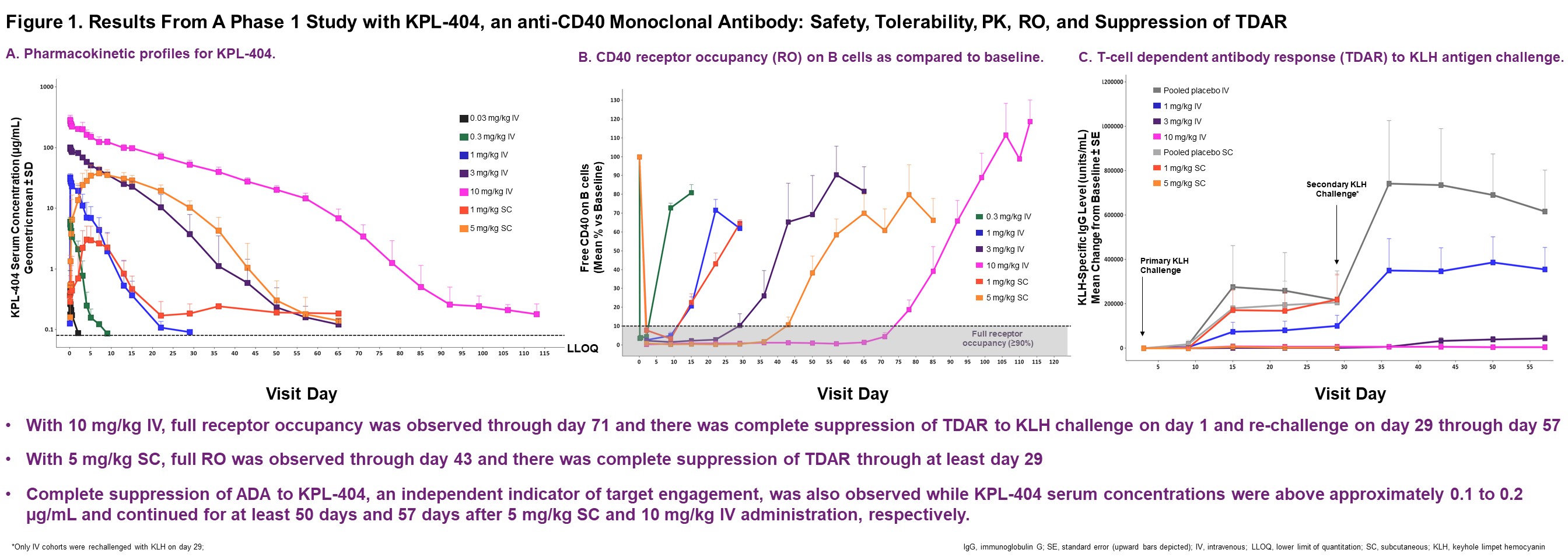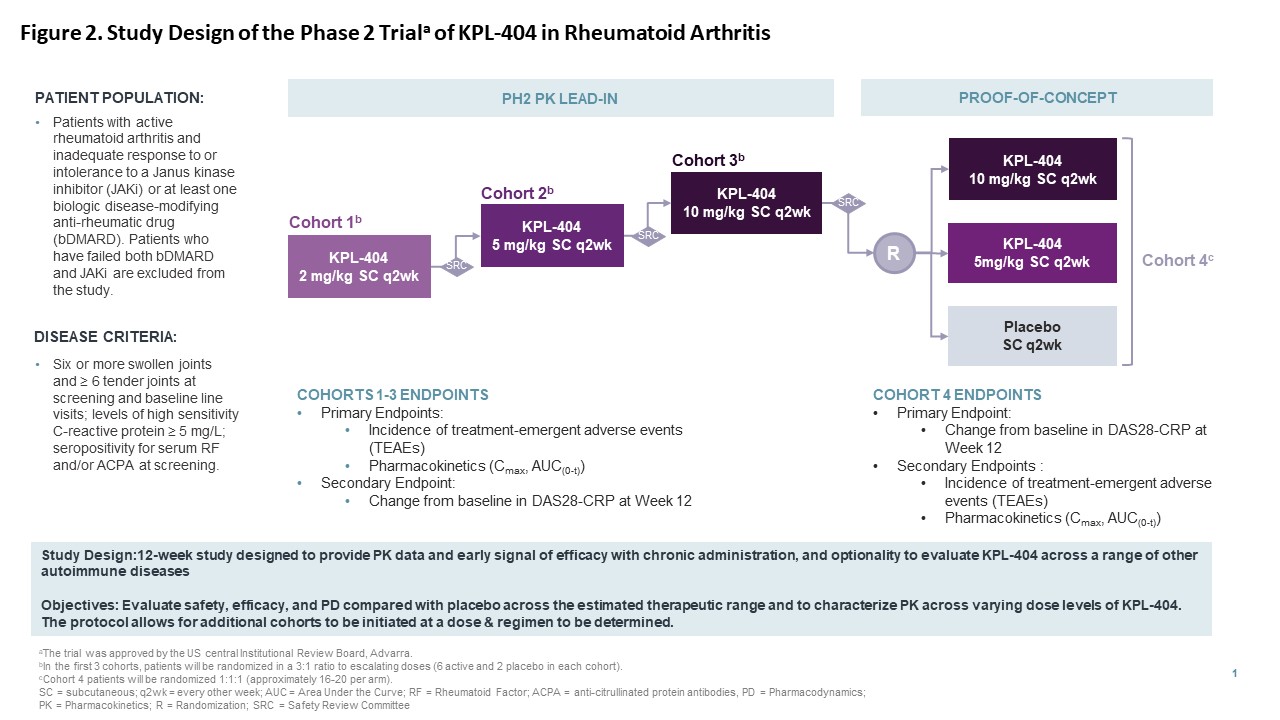Back
Poster Session A
Rheumatoid arthritis (RA)
Session: (0272–0316) RA – Treatment Poster I
0312: Dose-dependent Suppression of T Cell-Dependent Antibody Response in Healthy Volunteers by KPL-404, an Anti-CD40 Monoclonal Antibody, Supports Phase 2 Study in Patients with Rheumatoid Arthritis
Saturday, November 12, 2022
1:00 PM – 3:00 PM Eastern Time
Location: Virtual Poster Hall
- JC
Jay Chatfield, MPH
Kiniksa Pharmaceuticals
Schwenksville, PA, United States
Abstract Poster Presenter(s)
Lara Pupim1, Gerd Burmester2, Fang Fang1, Alan Kivitz3, Moses Njenga1, Costantino Pitzalis4, Jay Chatfield1, Anastassia Papandrikopoulou1, Manoj Samant1, Steve Schmitz1, Madeline Spiers1, Eben Tessari1, John Ziemniak1 and John F. Paolini5, 1Kiniksa, Lexington, MA, 2Charité University Medicine Berlin, Berlin, Germany, 3Department of Rheumatology, Altoona Center for Clinical Research, Duncansville, PA, 4Queen Mary University of London, London, United Kingdom, 5Kiniksa Pharmaceuticals, Lexington, MA
Background/Purpose: An unmet need remains in patients with failure and/or inadequate response (IR) to biological disease-modifying antirheumatic drugs (bDMARD-IR) and/or Janus kinase inhibitors (JAKi-IR). The CD40/CD40L (CD154) costimulatory interaction is linked to inflammation and joint destruction in RA via production of autoantibodies and inflammatory mediators. KPL-404 is a humanized IgG4 antibody engineered to bind CD40 without triggering Fc effector functions.
In a first-in-human Phase 1 single ascending dose study, 52 healthy volunteers received single doses of KPL-404 administered either subcutaneously (SC) or intravenously (IV) with no dose-limiting safety findings, infectious episodes, or toxicities. Pharmacodynamic assessments suggested full target engagement and dose-dependent suppression of TDAR for primary and secondary KLH challenge were achieved at pharmacologically relevant concentrations (Figure 1).
Using Phase 1 and nonclinical data, identify chronic dosing regimens anticipated to yield PK in the sub-therapeutic, therapeutic, and supra-therapeutic ranges to be utilized in a Proof of Concept Phase 2 Study.
Methods: A PK model was used to simulate multiple dosing scenarios, including: 2.5, 5, and 10 mg/kg SC qwk, q2wk, and q4wk, as well as 10 mg/kg IV q4wk. The model was used to identify optimal Phase 2 dosing schedules by generating 1000 virtual subjects using the typical parameter estimates with between-subject variability included.
Results: Following SC administration, all subjects were predicted to achieve complete ADA suppression for the full dosing interval at/above 2.5 mg/kg SC q2wk. At 2 mg/kg SC q2wk (starting dose level), simulated steady-state 8-week data predicted PK in a sub-therapeutic range for most subjects and an approximately 31- and 18-fold safety margin relative to preclinical NOAEL dose. At 5 mg/kg SC q2wk, 100% of patients were predicted to be in a therapeutic range, indicating a potential practical efficacious dose level. At 10 mg/kg SC q2wk, 100% of patients were predicted to be in the supratherapeutic range.
These results support a Phase 2 study design, with Multiple Ascending Dose (MAD) PK lead-in (Cohorts 1-3) and a Proof-of-Concept Cohort (Cohort 4) (Figure 2). The ongoing study will evaluate efficacy (Disease Activity of 28 joints using C-reactive protein [DAS28-CRP]), safety, PK, and pharmacodynamics (PD) of escalating dose levels of KPL-404 compared with placebo in patients with moderate to severe RA (bDMARD-IR or JAKi-IR). The study also allows the flexibility of optional cohorts including additional dosing regimens and/or subpopulations identified based on clinical response and biomarkers.
Conclusion: Inhibition of the CD40-CD154 co-stimulatory interaction holds promise for the management of a spectrum of autoimmune diseases. KPL-404 demonstrated prolonged absorption/excretion capable of suppressing TDAR for extended periods allowing for use of extended dosing intervals irrespective of IV or SC dosing. These analyses supported the design of the ongoing Phase 2 study assessing the efficacy and safety KPL-404 in RA.
 Figure 1. Results From A Phase 1 Study with KPL-404, an anti-CD40 Monoclonal Antibody: Safety, Tolerability, PK, RO, and Suppression of TDAR
Figure 1. Results From A Phase 1 Study with KPL-404, an anti-CD40 Monoclonal Antibody: Safety, Tolerability, PK, RO, and Suppression of TDAR
 Figure 2. Study Design of the Phase 2 Trial of KPL-404 in Rheumatoid Arthritis
Figure 2. Study Design of the Phase 2 Trial of KPL-404 in Rheumatoid Arthritis
Disclosures: L. Pupim, Kiniksa; G. Burmester, AbbVie, Galapagos, Lilly, MSD, Pfizer, Roche, UCB, Janssen, Gilead Sciences, Inc.; F. Fang, Kiniksa; A. Kivitz, Amgen, Boehringer-Ingelheim, Janssen, Gilead, GlaxoSmithKlein (GSK), Novartis, Pfizer, Sanofi, Flexion, Eli Lilly, Genentech, UCB, AbbVie, Merck, ECOR1 CAPITAL, LLC, Chemocentryx, Regenerson, Grunenthal, Bendcare, Horizon; M. Njenga, Kiniksa; C. Pitzalis, AbbVie/Abbott, Astellas, Astra-Zeneca/MedImmune, BMS, CelGene, Grunenthal, GSK, Johnson/J&J, Kiniksa, MSD, Pfizer, Sanofi, Roche/Genentech/Chugai, UCB; J. Chatfield, Kiniksa; A. Papandrikopoulou, Kiniksa; M. Samant, Kiniksa; S. Schmitz, Kiniksa; M. Spiers, Kiniksa; E. Tessari, Kiniksa; J. Ziemniak, Kiniksa; J. Paolini, Kiniksa.
Background/Purpose: An unmet need remains in patients with failure and/or inadequate response (IR) to biological disease-modifying antirheumatic drugs (bDMARD-IR) and/or Janus kinase inhibitors (JAKi-IR). The CD40/CD40L (CD154) costimulatory interaction is linked to inflammation and joint destruction in RA via production of autoantibodies and inflammatory mediators. KPL-404 is a humanized IgG4 antibody engineered to bind CD40 without triggering Fc effector functions.
In a first-in-human Phase 1 single ascending dose study, 52 healthy volunteers received single doses of KPL-404 administered either subcutaneously (SC) or intravenously (IV) with no dose-limiting safety findings, infectious episodes, or toxicities. Pharmacodynamic assessments suggested full target engagement and dose-dependent suppression of TDAR for primary and secondary KLH challenge were achieved at pharmacologically relevant concentrations (Figure 1).
Using Phase 1 and nonclinical data, identify chronic dosing regimens anticipated to yield PK in the sub-therapeutic, therapeutic, and supra-therapeutic ranges to be utilized in a Proof of Concept Phase 2 Study.
Methods: A PK model was used to simulate multiple dosing scenarios, including: 2.5, 5, and 10 mg/kg SC qwk, q2wk, and q4wk, as well as 10 mg/kg IV q4wk. The model was used to identify optimal Phase 2 dosing schedules by generating 1000 virtual subjects using the typical parameter estimates with between-subject variability included.
Results: Following SC administration, all subjects were predicted to achieve complete ADA suppression for the full dosing interval at/above 2.5 mg/kg SC q2wk. At 2 mg/kg SC q2wk (starting dose level), simulated steady-state 8-week data predicted PK in a sub-therapeutic range for most subjects and an approximately 31- and 18-fold safety margin relative to preclinical NOAEL dose. At 5 mg/kg SC q2wk, 100% of patients were predicted to be in a therapeutic range, indicating a potential practical efficacious dose level. At 10 mg/kg SC q2wk, 100% of patients were predicted to be in the supratherapeutic range.
These results support a Phase 2 study design, with Multiple Ascending Dose (MAD) PK lead-in (Cohorts 1-3) and a Proof-of-Concept Cohort (Cohort 4) (Figure 2). The ongoing study will evaluate efficacy (Disease Activity of 28 joints using C-reactive protein [DAS28-CRP]), safety, PK, and pharmacodynamics (PD) of escalating dose levels of KPL-404 compared with placebo in patients with moderate to severe RA (bDMARD-IR or JAKi-IR). The study also allows the flexibility of optional cohorts including additional dosing regimens and/or subpopulations identified based on clinical response and biomarkers.
Conclusion: Inhibition of the CD40-CD154 co-stimulatory interaction holds promise for the management of a spectrum of autoimmune diseases. KPL-404 demonstrated prolonged absorption/excretion capable of suppressing TDAR for extended periods allowing for use of extended dosing intervals irrespective of IV or SC dosing. These analyses supported the design of the ongoing Phase 2 study assessing the efficacy and safety KPL-404 in RA.
 Figure 1. Results From A Phase 1 Study with KPL-404, an anti-CD40 Monoclonal Antibody: Safety, Tolerability, PK, RO, and Suppression of TDAR
Figure 1. Results From A Phase 1 Study with KPL-404, an anti-CD40 Monoclonal Antibody: Safety, Tolerability, PK, RO, and Suppression of TDAR Figure 2. Study Design of the Phase 2 Trial of KPL-404 in Rheumatoid Arthritis
Figure 2. Study Design of the Phase 2 Trial of KPL-404 in Rheumatoid ArthritisDisclosures: L. Pupim, Kiniksa; G. Burmester, AbbVie, Galapagos, Lilly, MSD, Pfizer, Roche, UCB, Janssen, Gilead Sciences, Inc.; F. Fang, Kiniksa; A. Kivitz, Amgen, Boehringer-Ingelheim, Janssen, Gilead, GlaxoSmithKlein (GSK), Novartis, Pfizer, Sanofi, Flexion, Eli Lilly, Genentech, UCB, AbbVie, Merck, ECOR1 CAPITAL, LLC, Chemocentryx, Regenerson, Grunenthal, Bendcare, Horizon; M. Njenga, Kiniksa; C. Pitzalis, AbbVie/Abbott, Astellas, Astra-Zeneca/MedImmune, BMS, CelGene, Grunenthal, GSK, Johnson/J&J, Kiniksa, MSD, Pfizer, Sanofi, Roche/Genentech/Chugai, UCB; J. Chatfield, Kiniksa; A. Papandrikopoulou, Kiniksa; M. Samant, Kiniksa; S. Schmitz, Kiniksa; M. Spiers, Kiniksa; E. Tessari, Kiniksa; J. Ziemniak, Kiniksa; J. Paolini, Kiniksa.

